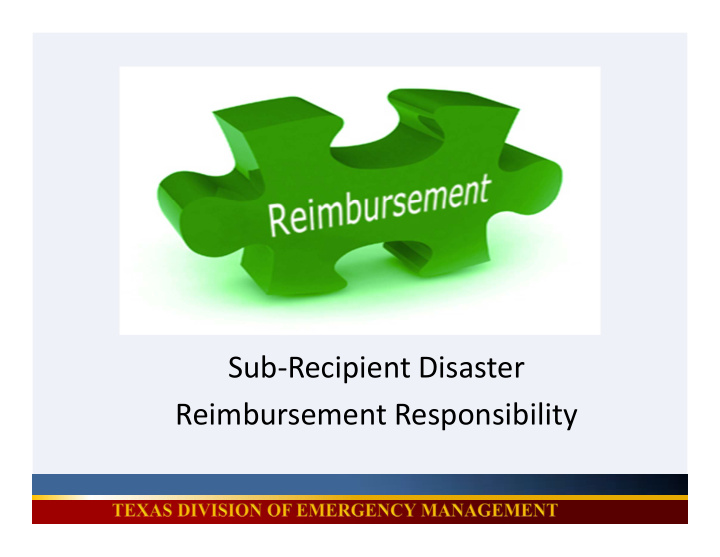



Sub‐Recipient Disaster Reimbursement Responsibility
Presentation Overview • Introduction • Why Document • Policy • Cost • Documentation • Grants Management Systems 2
Introduction Pat McGraw Grant Coordinator Pat.mcgraw@tdem.texas.gov 512‐994‐8568
Why Document The Public Assistance Program is a reimbursement program that provides funding to eligible applicants who have suffered damages as a result of a Presidential disaster declaration and whose damages are within a designated area for Public Assistance. Funding under this program is limited to repairing or replacing damaged items/facilities to their pre‐disaster condition at the approved cost share. *Document everything you spend time and money on. Must maximize insurance claim efforts FEMA is funding of last resort
Policy Key Statues and Authorities • Robert T. Stafford Disaster Relief and Emergency Assistance Act, amended (Stafford Act) • 44 CFR Section 206 – Federal Disaster Assistance • 2 CFR Section 200 – Uniform Administrative Requirements, Cost Principles, and Audit Requirements for Federal Awards • Executive Order No. GA‐05 Emergency Management • Public Assistance Program and Policy Guide 5
Cost Eligibility Generally, costs that can be directly tied to the performance of eligible work. Cost Must Be: • Reasonable and necessary to accomplish the work • Authorized and not prohibited under Federal, State or local government laws or regulations. • Reduced by all applicable credits, such as insurance proceeds and salvage values. Must Maximize all other $ resources
Tracking Cost by Categories Emergency Work A Debris Removal B Emergency Protective Measures Permanent Work C Roads and Bridges D Water Control Facilities E Buildings and Equipment F Utilities G Parks, Rec. Facilities & Other Items
Tracking Cost by Project • Small Projects • Large Completed Projects • Compliance Monitoring (Incomplete Large Projects) • Final Compliance Review
How to Document DOCUMENT EVERYTHING YOU SPEND TIME & MONEY ON! 1. Force Account Labor – your staff (regular or new hire) 2. Force Account Equipment – equipment you own 3. Materials – on hand and purchase 4. Contracts – from the beginning through the whole process 5. Rental – equipment and facilities 6. Travel – meals, lodging, etc.
Supporting Documentation • Time Keeping Policy • Purchasing Policy • Mutual Aid Ploicy • Insurance Policy • Personnel Policy • Vehicle Ownership
Force Account Labor These are your people on your payroll. Eligible Labor Costs for your jurisdiction’s employees Regular Time Support Documents Overtime Crew time reports, Activity Logs, timesheets Comp Time Proof of hourly or pay period rate (HR) Fringe Fringe Benefit Rate for each employee or an department average Proof of payment – payroll history, check stubs, bank statements Overtime and comp time policy for exempt and non‐exempt employees, part‐time employees and volunteers
Force Account Equipment This is the equipment your department, agency, town or city owns. Force Account Equipment Force Account Labor - Operator Eligible Equipment Costs Actual in-use working hours ( standby and idle time maybe eligible) Mileage rate versus hourly rate TIFMAS only reimburses at an hourly rate Support Documents Equipment logs identifying Proof of equipment ownership operator and signed by (title, registration, ect) operator & supervisor Equipment rate calculations Operator timesheets, CTRs, (local, State or FEMA rate) Activity Reports
Materials The materials and supplies used that you owned prior to the disaster or purchased as a result of the disaster. Eligible Materials Costs Materials and supplies taken from existing stock Materials and supplies purchased Support Documents List of materials used with pricing Invoices & Purchase Orders Proof of payment (cancelled checks, bank statements) Purchasing procedure policy
Rentals / Leases You pay to use someone else’s property/equipment for a specified amount of time. Eligible Costs Support Documents o Required as a result of the o Rental/Lease agreement event o Invoices o Reasonable costs – Can’t o Purchase Orders exceed a purchase price o Proof of Payment o Equipment use logs
Contracts Contracts must be of reasonable cost, generally must be competitively bid, and must comply with local jurisdiction, State and Federal procurement standards. Eligible Costs Support Documents • Lump Sum Contracts • Contract procurement policy • Unit Price contracts • Bid & Selection process • Cost Plus Fixed Fee contracts • Debarment check • Time and Materials contracts • Contracts (immediate need, time sensitive) • Invoices/Purchase Orders Cost Plus A Percentage of Costs: not allowed • Proof of Payment
Debris Contracts Properly Procured Monitoring Contracts Procured Force Account Labor Load Tickets Truck Certification What was picked up Where it was picked up from Dump/Burn Sites TCEQ & THC certified/approved Final Disposition Land Fill Recycling Center
Insurance Documentation Insurance policy coverage in effect prior to the event Schedule of Value Declaration Page Insurance Adjuster’s Assessment of Damage and loss Carrier’s summary of loss Carrier’s Statement of loss Carrier’s Sworn Statement in Proof of loss Copies of proceed checks and any explanation that accompanied the checks ( including advances received ) Breakdown of how insurance was applied to each project * FEMA request the whole insurance policy
Reimbursement Tips Identify employee for record keeping Establish separate revenue/expenditures accoutns Create separate files for each FEMA project Ensure expenditures reference source documentation File for & credit insurance payment to FEMA project
Frequent Audit Findings ‐ OIG Improper Contracting Practices o Unsupported Costs o Poor Project Accounting o Excessive Equipment Charges o Unapplied Credits o Excessive Labor and Fringe Benefit Charges o Duplication of Benefits o Unrelated Project Charges o Direct Administrative Costs o Obtain and Maintain Insurance o
Grants Portal FEMA’s online grants management system
Grants Management System TDEM’s Online management system
Questions?
Region 1, District 6 Josh Roberts Assistant Chief (214) 470-9185 Andrea Lowe Unit Chief (214) 861-2057 Deaun Stinecipher Karen Hershey Pat McGraw District Coordinator Regional Disaster Finance Coordinator Grant Coordinator (903) 393-6072 (903-343-3432 (512) 994-8568 Should you have any question after today here are the contacts for District 6 .
Recommend
More recommend